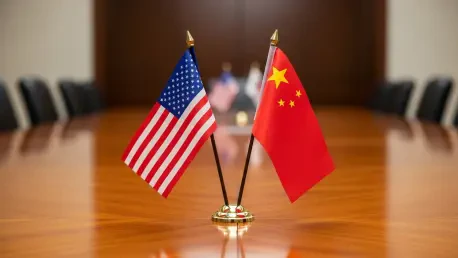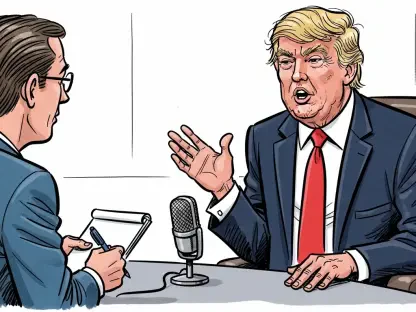In a world where economic rivalries often overshadow global cooperation, the recent trade truce between the United States and China stands out as a significant development, especially given the tensions over critical resources and public health crises that have shaped bilateral relations for years. This agreement, which addresses rare earth exports, fentanyl precursor controls, and semiconductor supply chains, has sparked intense discussion across industries and policy circles. The purpose of this roundup is to gather diverse perspectives from industry leaders, policymakers, and analysts, offering a comprehensive look at what this truce means for stakeholders and whether it signals a lasting shift or a temporary reprieve in the complex US-China dynamic.
Diverse Views on the Trade Breakthrough
Rare Earth Exports: A Win for Industry or a Risky Bet?
Industry representatives from the tech and defense sectors have largely welcomed China’s decision to ease export controls on rare earths and related materials like gallium and germanium. Many highlight the immediate relief for manufacturers of semiconductors and solar panels, noting that supply chain disruptions have long hindered production timelines and inflated costs. A consensus among business leaders points to this as a vital step toward stabilizing access to critical materials, which is essential for both economic growth and national security.
However, not all opinions align on the long-term reliability of this concession. Some policy analysts express concern over China’s history of using resource exports as leverage in geopolitical disputes. They argue that while general licensing for these materials offers short-term benefits, the lack of a binding framework raises doubts about sustained access, urging US companies to continue seeking alternative suppliers.
A third perspective emerges from economic strategists who see this as a mixed opportunity. They suggest that while the truce reduces immediate strain, it could delay necessary diversification efforts if American firms become overly reliant on Chinese supply. This group advocates for a balanced approach, combining the benefits of the current agreement with investments in domestic production capabilities.
Fentanyl Precursor Controls: Hope Amid Uncertainty
On the issue of China’s pledge to curb exports of fentanyl precursor chemicals, public health advocates view this as a landmark moment in addressing the US opioid epidemic. Many emphasize the potential for reduced drug trafficking through Mexico, a major conduit for these substances, and commend the bilateral effort to tackle a crisis that claims countless lives annually. The optimism centers on the possibility of meaningful cooperation extending beyond trade into humanitarian concerns.
Contrasting this hope, several drug policy experts caution against overconfidence due to the absence of detailed enforcement mechanisms in the agreement. They point out that without transparent monitoring systems, the risk of non-compliance remains high, potentially undermining the impact of China’s commitments. This skepticism is fueled by past challenges in tracking illicit chemical flows across borders.
A more pragmatic stance comes from international relations specialists who argue that even imperfect agreements can lay the groundwork for future collaboration. They note that while specifics are lacking, the public commitment itself pressures both nations to follow through, suggesting that incremental progress on this front could build trust over time. Their advice focuses on establishing joint task forces to ensure accountability.
Semiconductor Supply Chains: Temporary Fix or Strategic Shift?
The resumption of trade from Nexperia’s facilities, aimed at easing the global shortage of legacy chips, has drawn mixed reactions from the automotive and tech industries. Many in these sectors express relief at the potential alleviation of production bottlenecks that have stalled manufacturing, especially for vehicles reliant on older chip technologies. This group sees the truce as a practical solution to an urgent problem affecting global markets.
On the other hand, geopolitical analysts highlight underlying tensions, pointing to conflicting statements from the Chinese Commerce Ministry about Dutch government interventions. They warn that such discrepancies reveal unresolved friction, questioning whether this deal can truly mend supply chain disruptions or if it merely postpones deeper conflicts over technological dominance. Their concern centers on the strategic importance of semiconductors in national security.
A balanced perspective from supply chain consultants suggests that while the agreement offers short-term gains, it does little to address the broader vulnerabilities of global chip dependency. They recommend that US policymakers and businesses use this window to accelerate investments in domestic semiconductor production, viewing the truce as a stopgap rather than a permanent resolution to systemic challenges.
Trust and Strategy: Can Cooperation Endure?
Among China policy hawks in the US, skepticism dominates discussions about Beijing’s reliability as a trade partner. Many in this camp cite historical policy reversals as evidence that the current truce may not hold under shifting political or economic pressures. Their position urges caution, advocating for robust contingency plans to mitigate risks of sudden changes in China’s stance.
In contrast, trade negotiation experts frame the agreement as a pragmatic win, arguing that small, focused deals like this one can build momentum for larger accords. They believe that success in implementing these commitments could reshape future dialogues, provided both sides demonstrate goodwill. This group stresses the importance of consistent diplomatic engagement to maintain progress.
A middle-ground opinion from economic think tanks suggests that the truce reflects a delicate balance of cooperation and competition. They speculate that while deeper collaboration is possible, it hinges on mutual accountability and the ability to navigate inevitable disagreements. Their analysis points to the need for clear benchmarks to evaluate the truce’s effectiveness over the coming years.
Key Implications and Practical Takeaways
For US businesses, the varied insights underscore the importance of diversifying supply chains despite the temporary relief offered by this truce. Industry leaders are encouraged to explore alternative sources for rare earths and chips, ensuring resilience against potential disruptions. This strategic planning remains crucial even as immediate pressures ease.
Policymakers, meanwhile, face calls to establish strong monitoring mechanisms for agreements like fentanyl precursor controls. Analysts across the board agree that transparency and enforcement will determine the success of these commitments, pushing for bipartisan efforts to create frameworks that hold both nations accountable.
For the broader public and stakeholders, staying informed about evolving US-China trade dynamics is essential. Engaging with industry reports, policy briefings, and expert analyses can provide clarity on how these issues impact daily life, from technology access to public health outcomes. Active participation in these discussions helps shape the future of such critical negotiations.
Reflecting on a Milestone in Trade Relations
Looking back, the discourse surrounding the US-China trade truce revealed a spectrum of hope, caution, and strategic thinking among experts and stakeholders. The insights gathered painted a picture of progress tempered by wariness, with each issue—rare earths, fentanyl, and semiconductors—carrying its own set of promises and pitfalls. Moving forward, the focus should shift to actionable measures, such as fostering international partnerships for supply chain security and investing in domestic innovation to reduce reliance on volatile trade agreements. Additionally, establishing regular bilateral reviews could help address emerging challenges before they escalate, ensuring that this truce serves as a foundation for stability rather than a fleeting moment in an ongoing rivalry.









